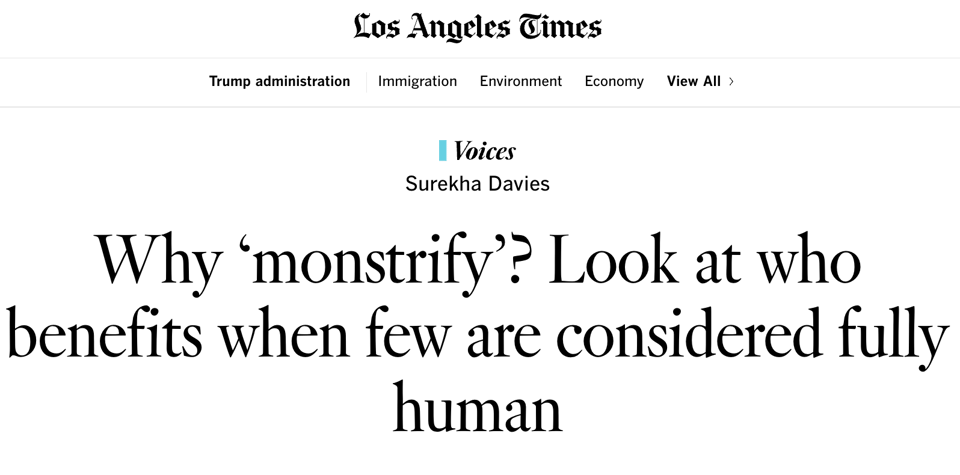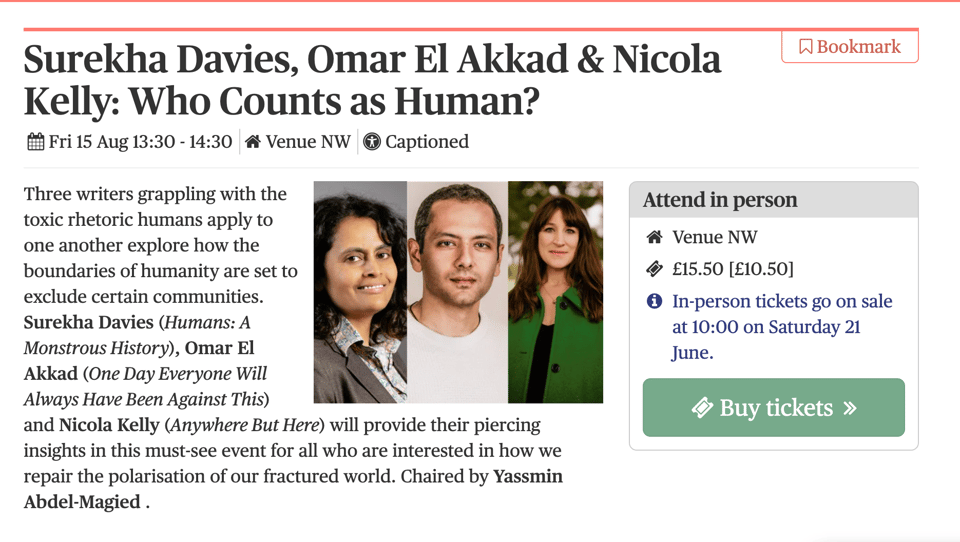An LA Times Op-Ed and the Edinburgh International Book Festival

Welcome back folks, and hallo, new readers!
In today’s newsletter:
An op-ed in the Los Angeles Times
Next book event - at the Edinburgh International Book Festival!
Lucas Cranach’s Allegory of Melancholy, 1528
A new angle to this newsletter
Why monstrify? Look at who benefits when few are considered fully human

This morning I had an op-ed published in the Los Angeles Times - my first-ever op-ed! In it I reflect on how the current US administration has used the word “monster” to justify abducting and trafficking people to El Salvador, the long history of monstrification in and beyond the US, why people have monstrified others, and offer a solution. As I say in the essay,
“[The] antidote is to realize that by recognizing the humanity of others we don’t disavow our own humanity: We demonstrate it. It behooves us to demand that all people receive equal protection under the law, and to call out monstrifying narratives that, in the end, dehumanize us all.”
Read the essay for free here.
Come and talk to me at the Edinburgh Book Festival, Fri Aug 15!

This summer, I’ll be speaking at the Edinburgh International Book Festival, a two-week book extravaganza in Edinburgh, Scotland. I’ll be in conversation with Omar El Akkad (One Day Everyone Will Always Have Been Against This) and Nicola Kelly (Anywhere But Here: How Britain’s Broken Asylum System Fails Us All), with Yassmin Abdel-Magied chairing our panel.
For someone who began her research career in history of science and Renaissance studies, the opportunity to connect the deep histories and hidden patterns behind the origins of the modern world with the work of authors steeped in understanding the recent past and the present is, well, mind-blowingly exciting. I’ll try not to combust with anticipation.
If you’re going to be within traveling distance of Edinburgh on Friday August 15, do considering attending the festival! Tickets go on sale on June 21st. You can check out the amazing programme online in the meantime.
Lucas Cranach’s monster of the mind?
To celebrate my upcoming trip to Edinburgh, here’s a strange and monstery artefact you can visit in the city.
One of my favourite painters is Lucas Cranach the Elder (1462-1553). The ethereal portraits and Earthly Paradise scenes (lots of Adam and Eve scenes) that glided out of his workshop conjure up an almost magical universe of long-limbed folx who stand or sit around thinking.
In the Scottish National Galleries in Edinburgh, I was thrilled to come across this painting of the Allegory of Melancholy (1528):

The mental state of melancholy appears as a person: the woman whittling a twig in the foreground, staring into the distance, oblivious to the plight of the pooch being roughed up by the four horsemen of the putti apocalypse.
In Renaissance European medicine physicians associated people’s temperaments with four bodily substances or humours: blood, phlegm, yellow bile, and black bile. As I write in Humans: A Monstrous History, this way of thinking had roots in classical antiquity, in the humoral model of the body. People understood the world beyond the body to affect the balance of these humours which, in turn, shaped a person’s temperament. Too much black bile made a person melancholic.
So what? you might ask. The alarming scene in the top left-hand corner paints an answer. A coven of witches - all naked, most of them women - ride barnyard and game animals through the sky; one of the riders isn’t even human. (For a Zoomable image of the painting minus glass reflection, click here):

People who were melancholic were supposedly more susceptible to the wiles of the devil. Witches were allegedly people who had given their service and loyalty to him rather than to God in exchange for unnatural powers.
The viewer is left to wonder: is this elegant lady with too much time on her hands at risk of becoming a witch? And what does that say about the mind-body-morals-fate connection?
The painting reads like a warning in the early years of the European witch hunt, something I write about in the “Gods, Magic, and the Supernatural” chapter of Humans: A Monstrous History. No one could be sure they could never turn into a witch, since everyone’s humours were malleable.
More Scottish monstery things to come in future newsletters. Subscribe to make sure you don’t miss them!
A sharper focus for this newsletter
Enter a slightly redesigned version of Notes from an Everything Historian, now called Strange and Wondrous: Notes from a Science Historian! The original title gave me carte blanche to write about everything from what will always be wrong with chatGPT to Paddington Bear. I’d come up with the title on the fly in November 2022 as I watched my post views on Twitter drop by ninety percent, almost overnight. Never was it so obvious that comms channels you don’t own - like a social media platform - are comms channels where you’re at the whim of the owners and their algorithms.
And so the “must devise a newsletter soon” to-do list item found itself rocketed to the top of the errand pile, and this newsletter came into being. So long as you, dear reader, wished to hear from me, you’d receive author news, notes about books, podcasts, and movies, and musings on strange and wondrous facets of the past and why they matter today, right in your Inbox. No doomscrolling on social media platforms necessary! (But you can chat with me on them; links at the end.)
Now that Humans: A Monstrous History is truly out in the world, it’s time to jump back into unearthing strange and wondrous things to write about here and maybe even to turn into the next book. Tweaking the newsletter title is supposed to remind me to dig up and explain the strange and the wondrous in the past. This time you’re in at the ground level of book idea research!
Have you come across anything vaguely historical of late that’s strange and wondrous? Things that blow your mind in inspiring ways? Or is there some you’d love for me to write about: vampires; haunted houses; a movie? (You can probably tell that I’m getting my brain into gear for pitching essays that might come out around Halloween.)
Feel free to comment on this post and let me know!
If you’d like more words from me you might enjoy Humans: A Monstrous History, just out from the University of California Press. It’s a history of humanity from antiquity to the present. I blend science, society, literature, and pop culture to show how and why people have invented monsters - category-breakers - in order to define the human in relation to everything from apes to space aliens.
Add a comment: